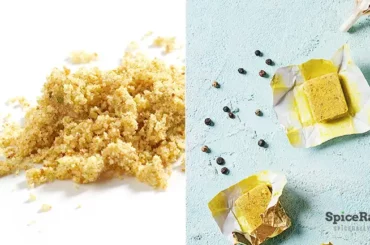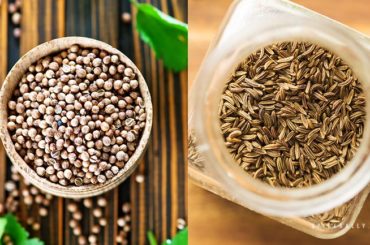Thai tom yum paste primarily provides the key flavor to the tom yum soup, along with many other uses But sometimes, we might not have it at home, so Thai tom yum paste substitutes help us!
You may not find a lot of alternatives in the market to match its taste. But still, there’s a handful of substitutes that can work, such as:
- Homemade tom yum paste
- Thai red curry paste
- Thai yellow curry paste
- Thai Massaman curry paste
- Curry laksa curry paste
- Assam laksa curry paste
- Thai red chili paste (Nam Prik Pao)
So, let’s see how these substitutes can be used instead of tom yum paste and how they are compared with the original paste.
The 7 Best Thai Tom Yum Paste Substitutes
Thai tom yum paste is a specially formulated ingredient to give a specific flavor to the tom yum soup dish. Even though this is not ranked among the basic curry pastes from Thai cuisine, it still holds an important place in Asian foods as much as a basic Thai curry paste would.

Since Thai tom yum paste has many other uses, the substitutes we will discuss in this article might be helpful in such instances. Thai tom yum paste usually comes together with ingredients such as:
- Thai red chiles
- Galangal
- Garlic
- Lemongrass
- Coriander roots and leaves
- Tamarind
- Kaffir lime peel/ leaves
- Dried shrimp/ shrimp paste
- Shallots
- Fish sauce
- Sugar
- Oil
The alternative should at least contain the main ingredients the original paste consists of and meet the flavor, aroma, and texture components to be a suitable replacement. We have listed a few of the best substitutes below so, check them out to find what suits your needs the best.
01- Homemade Thai Tom Yum Paste
We would like to start with the best and the closest substitute for our topic leader. If you’re used to using store-bought Thai tom yum paste options, and unable to restock, you can make your own batch at home. A homemade recipe will work as much better as your shop-bought stuff.
Making Thai tom yum paste is not a tough job when you have the right ingredients and a great recipe.
Pros of using Homemade Thai Tom Yum Paste:
- Homemade Thai tom yum will give you the exact taste, texture, and effect, similar to what you usually buy from the store.
- Can be used with anything that calls for the original products.
- Could be a much healthful option than what you buy from the store
- Comes with the ultimate versatility to control the ingredients you use in your tom yum paste.
Cons of using Homemade Thai Tom Yum Paste:
- The shelf life may be less than the shop-bought options since no artificial additives, or preservatives are typically included.
- You may sometimes find it hard to get the required ingredients to make the tom yum paste at home since it calls for traditional Thai ingredients like kaffir lime leaves, galangal, etc.
02- Thai Red Curry Paste
Ubiquitous Thai red curry paste is the most commonly used type of curry paste in Thai cuisine. The base of this curry paste is built up with the same ingredients used in the Thai tom yum paste which are, red chiles, lemongrass, galangal, and kaffir lime leaves. It also shares other common ingredients such as shrimp paste, coriander root, shallots, garlic, salt, etc.
However, Thai red curry paste may lack the tanginess and the slight sweetness of the tom yum paste since it does not typically contain a souring agent or a sweetener. But still, this would be the next alternative to be used in place of our topic leader.
Also, we can recommend the Thai red curry paste as a good fit for the tom yum soup. You can use it in a 1:1 ratio, or adjust the amount depending on your taste preference.
Pros of using Thai Red Curry Paste:
- This option is widely available in any leading supermarket, online shopping site, or Asian store.
- The level of spiciness and heat can be comparable to that of the tom yum paste.
- It gives a lovely depth of flavor and especially a good color compared to the original paste.
- Can be used in any application that originally calls for the tom yum paste.
Cons of using Thai Red Curry Paste:
- Lacks the sour and sweet flavor notes of the Tom yum paste. Therefore, you might need to add some lime juice/ tamarind paste and sugar to balance out the flavor.
- Generally, cumin seeds and coriander seeds are included in the red curry paste so it might not be very favorable to the ones who don’t like the taste of those spices in their soup.
03- Thai Yellow Curry Paste
Our next pick is the famous Thai yellow curry paste, used as much as the red curry paste in Thai cooking applications. This curry paste belongs to the same Thai curry paste family and interestingly shares the same base flavor as our topic leader.
Thus, while Thai chiles, galangal, lemongrass, and kaffir lime leaves account for the key flavor element of this option, it also shares some ingredients such as garlic, shrimp paste, and salt. Thai yellow curry paste is bolder in spiciness due to its many spices including turmeric, coriander seeds, and curry powder.
But it includes a lesser number of chiles when compared to the tom yum paste. Therefore, we do not recommend using this as the primary ingredient in the tom yum soup but it is good to go with other applications. You can start with a small amount of Thai yellow curry paste and adjust the amount later as you go.
Pros of using Thai Yellow Curry Paste:
- A similar texture can be obtained especially when incorporated with coconut milk.
- Gives a more concentrated flavor and color than the tom yum paste.
- Is an excellent choice for those who crave a spicier undertone.
- Readily available even outside of Thailand.
Cons of using Thai Yellow Curry Paste:
- Do not typically contain the sourness and sweetness as in the tom yum paste. So, you may want to balance out the flavor by mixing some tamarind paste/ lime juice with a sweetener like sugar to get the desired taste.
- Not a very good choice for those who expect a neutral-colored dish since the yellow curry paste can give a contrasting color to the dishes due to the inclusion of turmeric and curry powder.
- Lacks the heat of the tom yum paste due to the fewer number of chiles included
04- Thai Massaman Curry Paste
The fourth on our list goes to another well-known Thai curry paste which is the Massaman curry paste. This is the key flavoring of traditional Thai massaman curries that are mainly main with chicken and beef. The main reason why we say that this is a good substitute for tom yum paste is the content of its base flavor.
Like most options mentioned in our list, this curry paste also shares the same base flavoring ingredients such as Thai red chiles, kaffir lime leaves, lemongrass, and galangal. In addition to the main ingredients, it also contains similar flavor elements such as garlic, shrimp paste, coriander roots, and shallots.
Nevertheless, Thai massaman curry paste tends to set itself apart from the rest of the Thai curry paste thanks to its robustness, obtained with the inclusion of dry-roasted and fresh spices. Therefore, you may find it a bit overwhelming to use it in the tom yum soup in place of the tom yum paste.
Yet, it is good to go with many other applications such as making the base for stir-fries, seasoning meat and seafood, etc. Accordingly, feel free to use this alternative in dishes you wish to use the tom yum paste, but start from a very small amount and then adjust the quantities as you develop the taste of the dish.
Pros of using Thai Massaman Curry Paste:
- Can obtain the same texture, with comparable heat.
- Is good in many recipes that originally call for Thai tom yum paste.
- Gives a vibrant, bolder flavor than the tom yum paste, especially when paired with coconut cream or milk.
Cons of using Thai Massaman Curry Paste:
- This substitute typically lacks the tartness and sweetness you usually get with the tom yum paste. So, you might have to count an additional step by mixing a souring agent like lime juice or tamarind paste with a sweetener like sugar to get a more balanced taste.
- Thai massaman curry paste is not the choice of those who don’t like the robust flavor of spices. In fact, Tom yum paste is much milder when compared with this alternative.
- Very less chance left of using this in the main tom yum soup dish due to its different flavor profile.
05- Curry Laksa Curry Paste
Curry laksa curry paste is the key ingredient that gives a hearty taste to the curry laksa dish. This is another popular Southeast Asian paste, enriched with ingredients that could be compared to that of the tom yum paste.
Ingredients such as red chiles, lemongrass, galangal, coriander roots, kaffir lime zest/leaves, dried shrimp, shrimp paste, etc., make this option an excellent choice to use instead of our topic leader. This ingredient may also contain some additional ingredients like Macadamia nuts, turmeric, coriander seeds, and cumin seeds, giving its identity as the curry laksa curry paste.
However, despite these additional ingredients, we find this substitution a great pick to be used in place of the tom yum paste as a secondary ingredient. You can use this alternative in the same quantity as you use the Tom yum paste. Or else, if you’re uncertain about using substitute ingredients, you can start with a small amount and adjust the quantities later to your taste preferences.
Pros of using Curry Laksa Curry Paste:
- A similar texture, flavor, and color can be obtained with comparable proportions of the ingredients. But, if the tartness of the tom yum paste is mandatory for you, you may need to fix it by mixing a souring agent like tamarind paste or lime juice.
- Lends the similar Asian touch that you usually get from the tom yum paste.
- Can be used in most applications that originally call for the tom yum paste.
Cons of using the Curry Laksa Curry Paste:
- Might not be suitable for the ones with nut allergies
- May have a bit stronger spiciness with lesser heat due to the addition of extra spices and a lesser amount of chiles.
- It might be a bit hard to find this in normal shops outside of Asia.
- Is not recommended to use in the tom yum soup as a primary ingredient.
06- Assam Laksa Curry Paste
Assam laksa curry paste might work the same as curry laksa curry paste when you don’t have our topic leader in hand. However, Assam laksa curry paste is considered a milder version of curry laksa curry paste, with a lesser amount of ingredients.
But still, its base flavor can be compared to that of the tom yum paste since it comes together with red chiles, lemongrass, shrimp paste, galangal, etc. It is less processed than the tom yum paste, yet it is a possible alternative to be used as a secondary ingredient in place of our topic leader.
If you’re an expert chef, we recommend starting with a 1:1 ratio. But, if you’re an amateur cook, you may begin with a little amount and then gradually adjust the amounts as you go. Assam laksa curry paste can be used as a base in soups that are not the tom yum, in stews and even to flavor up sti-fried, depending on your choice.
Pros of using Assam Laksa Curry Paste:
- A similar spiciness, heat, texture, and color can be obtained.
- Can be used in many cooking applications that originally require the presence of tom yum paste.
- Gives a similar Asian kick to your foods.
Cons of using Assam Laksa Curry Paste:
- Lacks the sourness and sweetness you usually get in the tom yum paste. Therefore, you may want to fix and balance the flavor by adding lime juice or tamarind paste with sugar.
- Do not typically include kaffir lime leaves or zest. So, if you crave the flavor of this ingredient, you may need to include it as an extra element.
- Sometimes you might find it hard to purchase outside Asian countries.
07- Thai Red Chili Paste (Nam Prik Pao)
The last option in our list is another famous Thai condiment which is the Thai red chili paste. Although we have included this alternative as another possibility to use instead of the tom yum paste, this is better to be left as your last choice, and let us tell you why.
Thai red chili paste might have the heat, sourness, and sweetness that you get in our topic leader but it does not typically contain other base flavors such as lemongrass, galangal, and kaffir lime leaves. And also, some Thai red chili paste options are way sweeter than the tom yum paste, making it less flavorful in terms of other flavor notes highlighted in the tom yum paste.
Therefore, this is not at all recommended to be used in the main tom yum soup dish but still, it is good to go with fried rice, stir-fries, and several other dishes that originally call for the tom yum paste. Regarding all the facts, we would like to suggest using this alternative depending on your palate. Because some might find it too much when you use it in a 1:1 ratio while some may find it less flavorful.
Pros of using Thai red chili paste:
- Desired heat, consistency, sourness, and sweetness can be obtained.
- Is widely available even in places outside Thailand.
- Can be used both as a condiment and a cooking ingredient.
Cons of using Thai red chili paste:
- Some Thai red chili paste recipes are too sweet so you may not get the desired result by using this product.
- Lacks the major flavor elements from lemongrass, kaffir lime leaves, and galangal.
- Is not a suitable ingredient to use in tom yum soup.
What’s Your Favorite Thai Tom Yum Paste Substitute?
Thai tom yum paste is a one-of-a-kind ingredient that is specifically made to flavor up the famous and delicious Thai tom yum soup. But this paste is also used in several other cooking applications, so we thought that you might want help from us to find a good substitute for this product. It was not an easy job to find a suitable substitution for the tom yum paste as it is a bit complex. But still, we have managed to make a list of the best possibilities for you. So, what’s your best pick- let us know!




